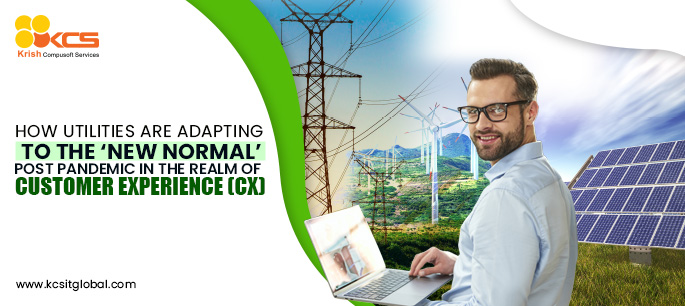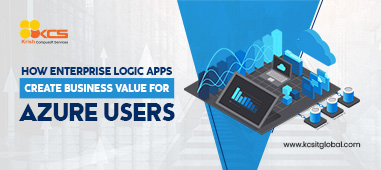
Category: Data Engineering & Analytics, Digital Transformation
How Utilities are Adapting to the ‘New Normal’ Post Pandemic in the Realm of Customer Experience (CX)
Introduction
The power and utility industry is undergoing a major transformation just as other industries, especially since the pandemic has triggered paradigm shifts in how everything and everyone operates. Today, customers have high expectations from their utility service providers and want a seamless customer experience, personalized approaches, streamlined customer services, enriched interactions, and highly impactful self-service options. Utility companies need to grab this opportunity to retain and grow their customer base, and to stay relevant in a fast-changing energy landscape.
Utilities are at a unique inflection point where they can create a new competitive edge by adopting new technologies to improve the customer experience, make their services available through multiple touchpoints and enhance their interactions with their customers. The question that most of the utilities are grappling with is how to cope with rapid changes in market conditions while keeping customer delight as their primary priority. Following are some of the challenges utilities are facing currently:
- Long-term impact of the pandemic on customer expectations
- Sustainability in utility operations
- Rise of clean energy consumption
- Demand for an omnichannel experience by the customers
- Issues of cybersecurity
What do Customers Want?
Today’s customers are proactive, well-informed, and demanding. They expect instant service delivery and a seamless omnichannel experience, and easy contact through any platform of their choice, be it on the phone, via the web, social media, apps, or in person. Most utilities rely on legacy systems and are not flexible or nimble enough to enable high-quality customer engagement. The advent of new digital technologies like IoT, artificial intelligence, machine learning, and big data analytics are changing the landscape of the customer service framework in which the utilities operate. Other elements like dynamic pricing structures are being used by utilities to strengthen their engagement with customers, provide the customers with opportunities to reduce energy bills, improve customer retention, and also to better manage peak demand.
Energy buying individuals and households specifically seek the following:
- Transparent approach in billing
- Consumption analysis of energy
- Ease-of-payment options to pay utility bills
- Focus on customer self-service initiatives
- Quick response to customer complaints
- Customized billing plans
- Flexibility to engage through the channel of their choice
- Supporting customers on their conservation, decarbonization, and electrification decisions
- Customers want utility offerings in new areas like electric vehicles and community energy
- Expect a 24x7 power supply, servicing their needs and receiving uninterrupted supply. They also expect more choices in the way electricity is produced, like connected distributed energy resources to the grid.`
- Today’s energy consumers are receptive to a utility marketplace where they can access numerous energy-efficient products. Various components of renewable energy sources are also offered in such marketplaces and also give customers more choice in the appliances they use.
- Due to the impact of the pandemic-induced lockdowns, customers want smoother self-service experiences from their utility providers. In addition, customers expect a quick resolution of their problems and queries by the utility call center staff.
- Expect instant information about the outage status when the supply is impacted and also want a quick resolution of the same
- Along with high-quality service, utility customers also want highly customized solutions as they are exposed to high degree of personalization on other digital channels and online stores, like e-commerce companies, or even retail companies. The days of mass marketing in the form of bulky newsletters, birthday emails, and other similar campaigns are over.
- Last but not the least, utility customers want an omnichannel experience in each of their interactions, enabling a streamlined customer experience. Smooth transition from one touchpoint to another, be it from one agent to the other in call centers or on a website or in-person interactions, is crucial for a customer.
What are Utilities Doing?
It is crystal clear what the power and utility companies need to do. They must provide high-quality customer experiences, reduce operating costs and discover new sources of revenue. As a precursor, utilities need to invest in strengthening their existing infrastructure and bringing in new technologies like smart meters, centralized operation centers, and distributed energy resources management systems. Utilities are also adopting cloud and advanced BI tools for real-time analysis of the huge quantities of data available to them. Some of their key focus areas are:
System optimization and transformation:
- Load analysis helps the utilities understand variations in consumption patterns, check whether their electrical systems are efficient and safe to take the requisite load, and prevent overload.
- This also helps in identifying problems with energy usage and unexpected fluctuations in usage and aiding uninterrupted power supply to the customers.
- To ensure 24x7 electricity supply while handling fluctuating demand, utilities also need to focus on proactive maintenance of their distribution assets like conductors, cables, and earthing systems right up to the households.
- Utilities are prioritizing the installation and integration of smart meters that provide accurate and real-time monitoring of electricity consumption. Data from smart meters is transferred through wireless networks and helps detect anomalies and monitor usage, leading to efficient operations and cost savings.
Operations transformation:
- Utilities are investing in centralizing and integrating their operations by bringing critical components such as SCADA, GIS, OMS together to enhance customer insights and system performance.
- The adoption of cloud technologies is enabling a transformation of real-time data to actionable insights.
- GIS technology is being implemented to track field assets and workers visually. Utilities can view the current location of field workers, monitor their progress, and guide them to the next outage. Outages can also be viewed on mobile devices in a repair vehicle. In addition, utilities can view the entire map of the grid, power transmission lines, and also, distributed energy resources for efficient functioning.
- Utilities also carry out an energy audit for their customers to identify suboptimal consumption patterns from different sources of energy and advise on becoming energy efficient.
Customer touchpoints:
- Utilities are finding that call centers are both inefficient and expensive. Service agents rarely possess the knowledge to address the queries of their customers. They also have to handle multiple windows, having to log in each time, to answer customer queries, leading to a poor experience for both the customers and the service agents.
- With the use of Intelligent Chatbots, customer complaints can be resolved faster. Prompt service helps in improving customer experience and retention.
- Utilities are finding new ways to help customers resolve errors in payments through reconciliation of the amount due.
- Personalization is a necessary ingredient for customer acquisition and retention. By using the customer data that utilities collect nowadays, they can gauge which customers are experiencing high electricity usage and recommend solar installations to them. Personalization also helps in upselling and cross-selling, and also results in customer retention.
Winning Customer Trust is Paramount
Traditionally, the interactions between utilities and their customers are about providing them with the energy bill and collecting timely payments. This limited scope of engagement has made it difficult for utilities to transform and project themselves as trusted allies of their customers. To counter this, utilities today are becoming more customer-centric by introducing omnichannel touchpoints and self-service portals for customer interactions. In this context, data from smart meters can be analyzed to provide personalized suggestions and services.
These initiatives can be greatly enhanced with a Customer Data Platform or CDP. Customer Data Platform is a collection of tools and applications that helps an organization to unify its various data sources, create a single golden customer record and a single version of the truth for all customer interactions, and make this data easily accessible to BI tools and personalization engines. A pre-built, customizable data platform comes with inherent advantages like faster deployment, optimized costs, and delivery of a powerful solution that exceeds the performance of grounds up, custom-built alternatives. Data gathered and compiled using customer data platforms helps companies to meet their customer expectations and serve up personalized experiences.
Advantages of Implementing a Customer Data Platform
A unified CDP enables an organization to access valuable customer data scattered across different sources in a single, unified platform. Armed with this end-to-end knowledge of the customer, utility companies can provide highly-customized, quality services. CDP helps utilities in streamlining their customer service operations and increases the knowledge base of the service agents leading to increased first-time resolutions and shorter call durations, thereby increasing the efficiency of the call centers. Integrating their CRM platforms with the CDP workflows will create integrated and seamless business processes. Unified data platform, combined with automation, helps utilities to deliver the right offer to the right customer at the right time through the right channel. A customer data platform not only helps in creating greater customer satisfaction, and an omnichannel experience, it can also help achieve regulatory compliance by ensuring the data is compliant with the latest data privacy regulations and security standards.
How do Customer Data Platforms strengthen Customer Experience for Power Utilities?
- Adopting a singular and interconnected customer platform that is data-driven and helps personalization is the future. For this purpose, technologies like AI, ML, and IoT are used. With such technologies, smart homes, electric vehicles, buildings, and others are transformed into higher efficiency operations.
- By providing their customers with options like energy marketplaces, utilities can attract customers with personalized incentives and also encourage the demand for energy-efficient products that are based on the purchase history of the customer.
- With the help of automated virtual assistants and chatbots, customer care operations can be optimized and can be made better and more sustainable. Such platforms help customers monitor and manage their energy consumption proactively.
- By strengthening the social media platforms that the utilities use, along with the capabilities like Conversational AI, utilities can provide better service to their customers, and this leads to better customer engagement by using the analytical insights provided.
KCS Value Proposition
KCS partnered with a leading power EPC company in North America in their digital transformation journey. We prepared a strategic plan for the company to remove gaps in the current processes to streamline operations. KCS also provided insights on a technology-agnostic solution for improving its operational capabilities. In addition, we conducted a detailed organizational assessment and technical analysis to prepare the future roadmap for the company.
In another instance, with the help of our Customer Data Platform solution, one of our clients, who is one of the leading global manufacturer and retailer of furniture, was able to use big data technologies to process 80 million unique customer identities and get valuable insights for implementing their digital transformation roadmap.
KCS has also been a digital transformation advisor to an electricity generation, transmission, and distribution giant having a customer base of 2.4 million. We digitally enabled the customers of this power utility company, through advanced solutions to improve their customer experience and enable better engagement with the utility. The huge quantities of data generated through such digital solutions helped the company to refine its customer offerings and provide customized services to them.
KCS has strong and proven in-house capabilities to create and deploy customized Customer Data Platforms and solutions to help enterprises to fast-track their digital transformation journey and to create and deliver highly effective CX strategies to gain high customer satisfaction scores.
The Way Forward
In conclusion, utility companies need to digitally transform their operations and leverage the huge quantities of customer data they are generating. Utilities are rapidly transforming their systems, operations, and customer touchpoints to be flexible and capitalize on the data. The digital era makes customers the uncrowned monarchs and the Customer Data Platform can provide unequivocal vantage point to a customer-centric utility company.
Recent posts
-
Top Trends in Modern Workplace
March 15, 2022
-
Top 4 Microsoft 365 Collaboration tools to Improve Business Productivity
November 29, 2021
-
4 Ways to Get Your Data in the Cloud with Azure Data Migration
November 12, 2021
Articles
-
How Utilities are Adapting to the ‘New Normal’ Post Pandemic in the Realm of Customer Experience (CX)
February 02, 2022
-
How Enterprise Logic Apps Create Business Value for Azure Users
November 15, 2021
-
Accelerate Your Journey To Smart Manufacturing Transformation - The Ecosystem Approach
October 26, 2021










